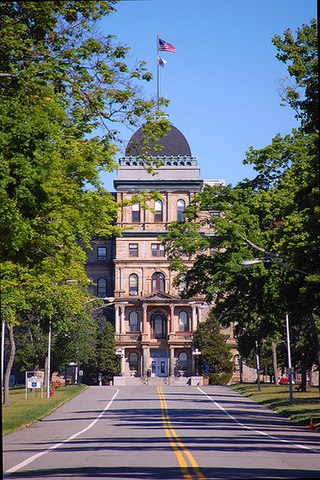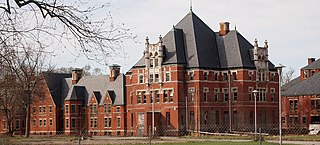
Pilgrim Psychiatric Center, formerly known as Pilgrim State Hospital, is a state-run psychiatric hospital located in Brentwood, New York. Nine months after its official opening in 1931, the hospital's patient population was 2,018, as compared with more than 5,000 at the Georgia State Sanitarium in Milledgeville, Ga. At its peak in 1954, Pilgrim State Hospital could claim to be the largest mental hospital in the U.S., with 13,875 patients. Its size has never been exceeded by any other facility, though it is now far smaller than it once was.

Greystone Park Psychiatric Hospital referred to both the former psychiatric hospital and the historic building that it occupied in Morris Plains, New Jersey. Built in 1876, the facility was built to alleviate overcrowding at the state's only other "lunatic asylum" located in Trenton, New Jersey.

The Crownsville Hospital Center was a psychiatric hospital located in Crownsville, Maryland. It was in operation from 1911 until 2004.

The Institute of Pennsylvania Hospital, also known as Kirkbride's Hospital or the Pennsylvania Hospital for Mental and Nervous Diseases, was a psychiatric hospital located at 48th and Haverford Streets in Philadelphia, Pennsylvania, USA. It operated from its founding in 1841 until 1997. The remaining building, now called the Kirkbride Center is now part of the Blackwell Human Services Campus.

Thomas Story Kirkbride was a physician, alienist, hospital superintendent for the Institute of the Pennsylvania Hospital, and primary founder of the Association of Medical Superintendents of American Institutions for the Insane (AMSAII), the organizational precursor to the American Psychiatric Association. Along with Benjamin Rush he is considered to be the father of the modern American practice of psychiatry as a specific medical discipline. His directive and organization of institutions for the insane were the gold-standard of clinical care in psychiatry throughout the 19th century.

Dixmont State Hospital was a hospital located northwest of Pittsburgh, Pennsylvania. Built in 1862, Dixmont was once a state-of-the-art institution known for its highly self-sufficient and park-like campus, but a decline in funding for state hospitals and changing philosophies in psychiatric care caused the hospital to be closed in 1984. After more than two decades of abandonment, it was demolished in 2006. The campus spanned a total of 407 acres (165 ha). Reed Hall is listed on the National Register of Historic Places.

Central State Hospital, formerly referred to as the Central Indiana Hospital for the Insane, was a psychiatric treatment hospital in Indianapolis, Indiana. The hospital was established in 1848 to treat patients from anywhere in the state, but by 1905, with the establishment of psychiatric hospitals in other parts of Indiana, Central State served only the counties in the middle of the state. In 1950, it had 2,500 patients. Allegations of abuse, funding shortfalls, and the move to less institutional methods of treatment led to its closure in 1994. Since then efforts have been made to redevelop the site for various uses.

The Norwich State Hospital, originally established as Norwich State Hospital for the Insane and later shortened to Norwich Hospital, was a psychiatric hospital that is located in Preston and Norwich, Connecticut. It opened its doors in October 1904 and it remained operational until October 10, 1996. Throughout its years of operation, it housed geriatric patients, chemically dependent patients and, from 1931 to 1939, tubercular patients. The hospital, which sits on the banks of the Thames River, began with a single building on 100 acres (40 ha) of land and expanded to, at its peak, over thirty buildings and 900 acres (360 ha).
Mendota Mental Health Institute (MMHI) is a public psychiatric hospital in Madison, Wisconsin, United States, operated by the Wisconsin Department of Health Services. The hospital is accredited by the Joint Commission. Portions of the facility are included in the Wisconsin Memorial Hospital Historic District, District #88002183. The Mendota State Hospital Mound Group and Farwell's Point Mound Group are also located at the facility.

Western State Hospital is a psychiatric hospital located at 9601 Steilacoom Boulevard SW in Lakewood, Washington. Administered by the Washington Department of Social and Health Services (DSHS), it is a large facility with 806 beds, and Washington's second-oldest state-owned enterprise.
The Hillsborough Hospital is a psychiatric hospital in Charlottetown, Prince Edward Island. It is the province's only mental health facility.

The Brattleboro Retreat is a private not-for-profit mental health and addictions hospital that provides comprehensive inpatient, partial hospitalization, and outpatient treatment services for children, adolescents, and adults.

Cherry Hospital is an inpatient regional referral psychiatric hospital located in Goldsboro, North Carolina, United States. As one of three psychiatric hospitals operated by the North Carolina Department of Health and Human Services, it provides services to 38 counties in the eastern region of North Carolina. It is part of the Division of State Operated Healthcare Facilities within the Department of Health and Human Services, which oversees and manages 14 state-operated healthcare facilities that treat adults and children with mental illness, developmental disabilities, and substance use disorders. The Division's psychiatric hospitals provide comprehensive inpatient mental health services to people with psychiatric illness who cannot be safely treated at a lower level of care.

Matteawan State Hospital for the Criminally Insane, established in 1892 as the Matteawan State Hospital by an 1892 law, functioned as a hospital for insane criminals. It was located in the town of Fishkill just outside the city of Beacon, New York; today its buildings form part of Fishkill Correctional Facility.
Bridgewater State Hospital, located in southeastern Massachusetts, is a state facility housing the criminally insane and those whose sanity is being evaluated for the criminal justice system. It was established in 1855 as an almshouse. It was then used as a workhouse for inmates with short sentences who worked the surrounding farmland. It was later rebuilt in the 1880s and again in 1974. As of January 6, 2020 there were 217 inmates in general population beds. The facility was the subject of the 1967 documentary Titicut Follies. Bridgewater State Hospital falls under the jurisdiction of the Massachusetts Department of Correction but its day to day operations is managed by Wellpath, a contracted vendor.
The Jacksonville Developmental Center was an institution for developmentally delayed clients, located in Jacksonville, Illinois. It was open from 1851 to November 2012. As of December 2012, the 134-acre (54 ha) grounds was still owned by the State of Illinois.

The Utah State Hospital (USH) is a mental hospital located in eastern Provo, Utah, United States of America. The current superintendent is Dallas Earnshaw.
The Mississippi State Hospital (MSH) is a psychiatric facility operated by the Mississippi Department of Mental Health. It is located in the unincorporated community of Whitfield, Rankin County, Mississippi, along Mississippi Highway 468. The 350-acre (140 ha) campus is 15 miles (24 km) southeast of Jackson, between Jackson and Brandon. Historically many people referred to the center as "Whitfield," after the community in which it is located.
Eastern State Hospital, located in Lexington, Kentucky, is the second oldest Psychiatric Hospital in the United States. It operates today as a psychiatric hospital with 239 beds providing inpatient care. Eastern State Hospital is owned by the Commonwealth of Kentucky, operated by the University of Kentucky's UK HealthCare and falls under the jurisdiction of the Cabinet for Health and Family Services.

The Maine Insane Hospital, later the Augusta Mental Health Institute (AMHI), was a psychiatric hospital in Augusta, Maine. It was the principal facility for the care and treatment of Maine's mentally ill from 1840 to 2004, and its surviving buildings represent the oldest surviving complex of mental care facilities in the United States. The complex is located on the east bank of the Kennebec River, immediately south of the former Kennebec Arsenal, and now primarily houses state offices. In 2004, the hospital was replaced by the Riverview Psychiatric Center, located just to the south. The hospital's core complex was listed on the National Register of Historic Places in 1982, with the listing enlarged to encompass the entire campus in 2001.














